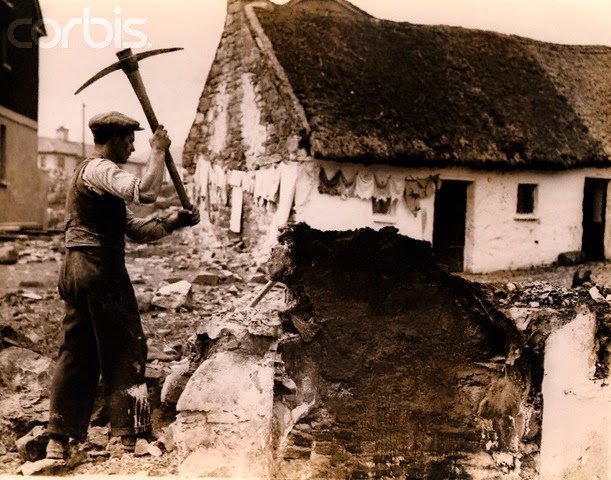Young lady of the Claddagh, 1931 (Corbis/Sexton)
The Claddagh, 1931 (Galway Advertiser/Sexton)
These are some of my favourite photos taken in Ireland for a number of reasons. First off, they beautifully and poignantly encapsulate the huge change the small community of the Claddagh was undergoing at the time. The people of the Claddagh had differed in custom and culture from other city dwellers just a short distance away and its array of thatched cottages seemed a relic of a bygone, more primitive era long before the 1930s. The fishing village's old world charm and unique customs attracted all manner of artists, photographers, and writers during the 19th and early 20th century.
The Claddagh, c1901 (Corbis)
The older houses, though picturesque, especially to tourists who typically had nicer abodes to go home to, were deemed unsuitable for modern living and were replaced with more comfortable but nondescript suburban housing which stands to this day. From a cursory search of contemporary newspapers it seems there was some local opposition to the rebuilding of the village. Some commented that the rents on the new dwellings was too high, others complained that if some work had been put into providing proper sanitation that the older cottages (some of which no rent was charged on) would be fine. Others still, with an eye on posterity and tourist dollars, marks, francs and pounds, suggested that at least a few of the finer examples of cottages should have been preserved.
Cartoon from Dublin Opinion, early 1960s
Beyond what these images specifically represent it is interesting to consider them in terms of broader societal changes in the wake of the creation of the Irish Free State. The 1920s had seen the establishment of 2RN, that national radio broadcaster, the construction of the ambitious Shannon Scheme, and the early 1930s would see the establishment of the first national commercial airline, Iona National Airways. As well as these technological and infrastructural changes, Ireland was continuing its long march from becoming a predominantly rural nation to becoming a largely urban and suburban one through a combination of migration to the towns and cities and the long blight of emigration. Although the Claddagh was not a rural village, part of its uniqueness was its existence in the midst of a modern city, it had a rural character that was all but totally erased by its redevelopment.
The powers that be in the Free State were often ambivalent about the march of social progress (see the 1930s anti-Jazz hysteria or the Mother and Child Scheme debacle of the 1950s for just two examples) yet at the same time, especially as regards Ireland's built history they could be callously proactive in replacing older structures. Having not been a resident of the Claddagh at the time I can't say for definite the village should or shouldn't have been so drastically rebuilt but it seems to me that maybe some compromise, as suggested at the time, might have been preferable. Contemporary accounts suggest that similar schemes in Dublin and other cities that created superior suburban housing for former tenement dwellers were also sometimes looked on in two minds, with many feeling a sense of dislocation from their former communities, despite obvious material improvements in their living conditions.
Workman demolishing cottage in The Claddagh, 1930 or 1931 (Corbis). Note the cottage directly behind is still occupied.
Renewal is of course always an issue, with successive governments facing damned if they do, damned if they don't criticism when they act to replace older dwellings and other structures. Tradition, history, heritage, are all also luxuries of those who already live in unquestioned modern comfort. Finally, perhaps what makes these images most resonate with the modern Irish viewer is how reminiscent the scenes are of the half-finished ghost estates that dot the Irish landscape at the present time, the result of bad planning, irrational exuberance, and systemic corruption. The Claddagh images contain the ghosts of the past, the image below, the ghosts of the future.
Ghost estate near Loughrea, Co. Galway, 2013 (Rolf Haid/Corbis)










